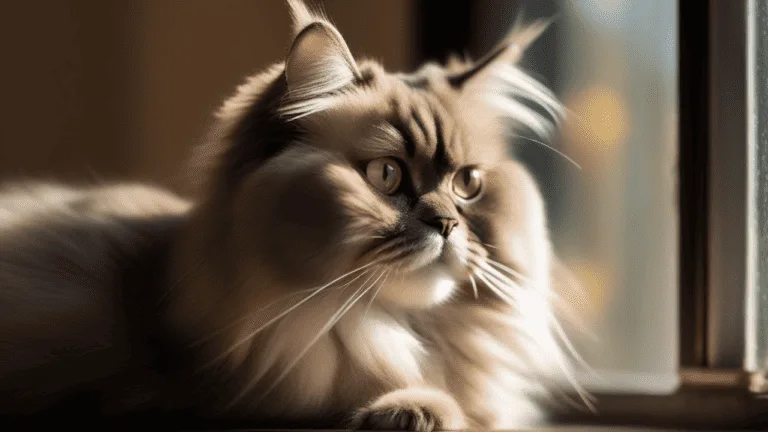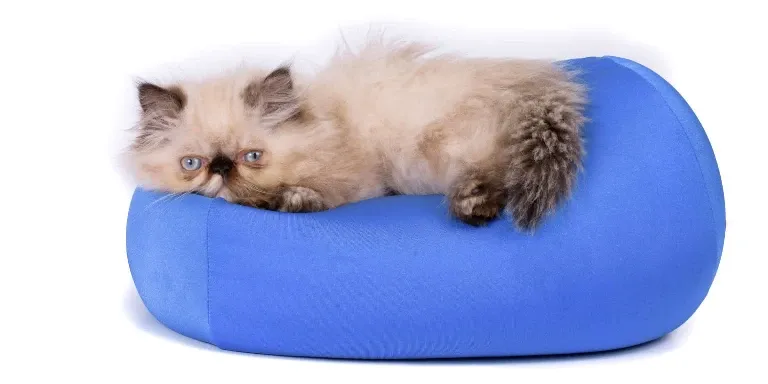The Best Fluffy Pancakes recipe you will fall in love with. Full of tips and tricks to help you make the best pancakes.

If you’re considering adding a Persian cat to your household, it’s important to understand their attitude and personality traits. Persian cats are known for their luxurious coats, gentle demeanor, and loving nature. However, they also require a significant amount of grooming and attention to maintain their health and well-being.
Persian cats are known for their laid-back, calm, and affectionate attitude. They are often described as being sweet-natured, gentle, and quiet. They enjoy being pampered and cuddled and are great lap cats. They are also independent and can entertain themselves for hours, but they also love to play and interact with their owners.
When it comes to attitude, Persian cats are typically laid-back and relaxed. They enjoy lounging around the house and cuddling up with their owners. However, they can also be independent and aloof at times, preferring to spend time alone rather than constantly seeking attention.
Understanding the attitude of a Persian cat is key to providing them with the proper care and environment they need to thrive. In this article, we will explore the different personality traits, socialization, communication, grooming, health issues, and training needs of Persian cats, so you can make an informed decision about whether a Persian cat is the right pet for you.
Overview of Persian Cats
If you’re looking for a feline companion that’s both regal and affectionate, you might want to consider getting a Persian cat. These fluffy balls of fur are known for their luxurious coats and laid-back attitudes.
In fact, Persians are one of the most popular cat breeds in the world, thanks to their charming personalities and stunning appearance. Persian cats have a rich history that dates back to ancient times. The breed originally hails from Persia, which is now modern-day Iran. These cats were highly prized by aristocrats and were often depicted in art and literature.
Today, the Persian cat is one of the most recognized breeds worldwide and is beloved by cat lovers everywhere. One of the most distinctive physical characteristics of a Persian cat is their long, flowing coat. This thick fur requires a lot of grooming to keep it in good condition, but it’s also what makes them so beautiful.
In addition to their coat, Persian cats have large, round eyes and a flat, squished face that gives them a unique appearance. Overall, the Persian cat is a stunning and regal breed that makes a wonderful pet for those looking for a loyal and affectionate companion.
Personality Traits
As a pet owner, you’ll quickly discover that a Persian cat has a unique temperament and disposition. Persians are known for their calm and gentle nature, making them an ideal pet for those seeking a peaceful companionship. They are not particularly active cats and prefer to lounge around the house, making them suitable for apartment living.
Despite their relaxed demeanor, Persians are also known for their playful side. They enjoy interactive play with their owners or playing with toys on their own. However, they are not known for their high energy levels and may tire easily. This means that they require regular playtime to keep them mentally stimulated and to prevent obesity.
Overall, a Persian cat’s attitude is one of tranquility and grace. They make wonderful pets for those seeking a calm and gentle companion. Their playful nature adds an element of fun to their personality, making them a great choice for families with older children or adults seeking a low-maintenance pet.
Socialization
Get to know your furry friend by socializing them with other animals and people. Persian cats are known to be social creatures, and it’s important to introduce them to new people and pets early on in their lives.
Here are some emotions you might feel when you socialize your Persian cat:
- Excitement: Seeing your Persian cat play with other animals can be an exciting experience. They’re known to be playful and curious creatures, and watching them explore their surroundings can be a joy to watch.
- Satisfaction: Introducing your Persian cat to new people and pets can be a satisfying experience. You get to see them make new friends and expand their social circle.
- Nervousness: Introducing your Persian cat to new people and pets can be nerve-wracking, especially if they’re not used to socializing. But with patience and positive reinforcement, they can learn to be comfortable around others.
- Love: As you watch your Persian cat interact with others, you may feel a sense of love and affection for them. Seeing them happy and playful can bring a smile to your face.
When it comes to playtime activities, Persian cats love interactive toys that mimic their hunting instincts. They enjoy chasing after toys that move quickly and unpredictably. You can also engage them in games of hide and seek by hiding treats around the house for them to find.
As for introducing them to new people and pets, it’s important to do so gradually and in a controlled environment. Start with short introductions and gradually increase the time they spend together. With patience and positive reinforcement, your Persian cat can learn to be comfortable around others and enjoy their company.
Communication
You’ll be blown away by the variety of sounds and body language your furry friend uses to communicate with you and other animals. Persian cats are known for being vocal and expressive creatures. From purring to hissing, meowing to growling, they have a range of vocalizations that they use to express themselves. However, nonverbal cues are just as important in understanding their communication.
Understanding body language is key in deciphering what your Persian cat is trying to tell you. For example, a cat that’s arching its back and puffing up its tail is likely feeling threatened or scared. On the other hand, a cat that’s rubbing against you and purring is showing affection and seeking attention. The way they hold their ears, the position of their body, and the way they move all convey important information.
Observing your cat’s behavior and understanding their nonverbal cues is crucial in building a strong bond with them. By paying attention to their body language, you can respond appropriately to their needs and strengthen your relationship.
Remember that communication goes both ways, so make sure to also communicate with your cat through your body language and vocalizations. With time and patience, you’ll become an expert in understanding your Persian cat’s unique language.
Grooming
When it comes to grooming your Persian cat, proper grooming is essential. This will keep their luxurious coat healthy and mat-free. Persian cats are known for their long, thick fur that requires regular brushing and maintenance.
Proper grooming can prevent matting, which can cause discomfort and skin irritation for your cat. It’s also important to keep your cat’s coat clean and free of debris, which can lead to skin infections. Regular grooming can also help prevent hairballs, a common issue for long-haired cats like Persians.
Hairballs occur when your cat ingests loose hair while grooming themselves, which can lead to digestive problems. Brushing your cat’s fur can help remove loose hair and prevent hairballs from forming. Additionally, proper grooming can help keep your cat cool during the summer months by removing excess fur and allowing air to circulate around their skin.
In addition to regular brushing, it’s important to bathe your Persian cat occasionally to keep their coat clean and healthy. However, be sure to use a cat-specific shampoo and avoid getting water in their ears. Proper grooming and coat maintenance will not only keep your Persian cat looking their best but also contribute to their overall health and well-being.
Health Issues
Taking care of your furry friend’s health is crucial to ensure they live a long and happy life. Persian cats are generally healthy, but like any other breed, they can develop health issues. Prevention measures are always better than treatments, and that’s why you should take your Persian cat for regular check-ups and vaccinations.
One of the most common health issues that Persian cats face is urinary tract problems. This can be caused by various factors, including a lack of water intake, a poor diet, and a lack of exercise. Prevention measures include providing your cat with fresh water, feeding them a healthy diet, and encouraging them to exercise regularly. If you notice any symptoms such as straining to urinate or blood in their urine, take your cat to the vet immediately.
Another common health issue that Persian cats face is dental problems. These cats have a small mouth, which can lead to overcrowding of teeth and an increased risk of gum disease. Prevention measures include brushing your cat’s teeth regularly, providing them with dental chews, and taking them for regular dental check-ups. Common dental problems in Persian cats include gingivitis, periodontal disease, and tooth decay.
By taking care of your cat’s dental health, you can prevent these issues from occurring and ensure that your cat has healthy teeth and gums. Taking care of your Persian cat’s health is important to ensure they live a long and happy life. Prevention measures such as regular check-ups and vaccinations can help prevent common health issues.
Common health issues in Persian cats include urinary tract problems and dental problems. By providing your furry friend with fresh water, a healthy diet, and regular exercise, as well as taking care of their dental hygiene, you can ensure that they stay healthy and happy.
Training
If you’re looking to train your Persian cat, there are a few key areas to focus on.
First, litter box training is crucial to ensure your cat uses the appropriate area to do their business.
Behavioral training can also be helpful in correcting any unwanted habits or behaviors.
Overall, Persians are known for their laid-back and affectionate personalities, making them great pets for those seeking a loving and low-maintenance companion.
Litter box training
Training your Persian cat to use the litter box can be challenging, but it’s a rewarding experience. It’s important to understand common mistakes that people make when litter box training their cats. One of the biggest mistakes is not cleaning the litter box frequently enough. This can lead to your cat avoiding the litter box altogether or finding another spot to use as their bathroom.
Positive reinforcement is key when training your Persian cat to use the litter box. When your cat successfully uses the litter box, give them praise and a treat. This will encourage them to continue using the litter box instead of finding other areas to use as their bathroom.
Additionally, it’s important to provide your cat with a litter box that is the appropriate size for them. A litter box that is too small or too large may make them uncomfortable and lead to them avoiding it.
With patience and consistency, your Persian cat will become litter box trained and confidently and cleanly take care of their business.
Behavioral training
To successfully teach good behavior to your Persian cat, you need to consistently reinforce positive actions and redirect negative ones. Positive reinforcement is key when it comes to training your cat. This technique involves rewarding your cat for good behavior, such as using the litter box, with treats or praise. By doing this, your cat will associate good behavior with positive outcomes and will be more likely to repeat the behavior in the future.
Another effective technique is clicker training. Clicker training involves using a small device that makes a clicking sound when pressed. You can use the clicker to mark positive behavior and then immediately reward your cat with a treat or praise. This technique is great for teaching your cat new tricks or behaviors, as it helps to create a clear association between the behavior and the reward.
To get started with clicker training, simply click the device when your cat exhibits a positive behavior, such as sitting or using the litter box, and then immediately reward them with a treat or praise. With consistent training and positive reinforcement, your Persian cat can learn to exhibit good behavior and be a joy to be around.
Summary of Persian cat attitudes
You can understand your furry Persian friend’s behavior by observing their body language, vocalizations, and actions. Persian cats are known for their calm and affectionate demeanor. They’re often described as docile and sweet-tempered, making them great lap cats. However, like any other breed, individual cats may display different temperament differences.
Breed-specific behavior is often associated with Persian cats. For example, they have a tendency to be more reserved and shy around strangers. They also have a reputation for being independent and aloof, although this can vary depending on the cat’s personality. It’s important to understand your Persian’s unique personality and provide them with the appropriate care and attention they need to thrive.
Why they make great pets
Surprisingly, despite their reputation for being aloof, Persian cats make wonderful companions for those seeking a calm and affectionate pet. As indoor cats, they’re content to spend their days lounging on a comfortable bed or in a sunny windowsill. Their easy-going nature makes them ideal for apartment living or for those who work long hours and can’t provide constant attention.
Additionally, their thick, luxurious coats are a joy to pet and groom, providing a relaxing and therapeutic activity for both the cat and owner. The benefits of ownership extend beyond their calming presence. Persian cats are known for bonding closely with their owners, often following them from room to room and seeking out their company.
This affectionate nature can provide a sense of comfort and companionship, particularly for those living alone or dealing with stress or anxiety. Overall, if you’re seeking a laid-back, loving companion, a Persian cat may be the perfect addition to your home.
What Is the Temperament of a Himalayan Cat Compared to a Persian Cat?
When it comes to Persian vs Himalayan cats, the temperament differs slightly. Persian cats are known for being calm and gentle, while Himalayan cats have a more playful and energetic nature. Both breeds are affectionate and make great companions, but their personalities have distinct differences.
Conclusion
So, you have a comprehensive guide to Persian cats! They are truly unique creatures that make wonderful pets. Their majestic appearance and loving personality are some of their best qualities.
While they may require more grooming and attention than other breeds, the rewards of owning a Persian are well worth the effort. Imagine coming home after a long day to find your fluffy Persian waiting for you, purring contentedly as it lounges on your lap.
Or watching as it playfully bats at a toy mouse, its big round eyes sparkling with joy. Persian cats truly have a special place in the hearts of their owners, thanks to their gentle demeanor and affectionate nature.
So, if you’re considering adding a feline friend to your family, why not consider a Persian? You won’t be disappointed!








